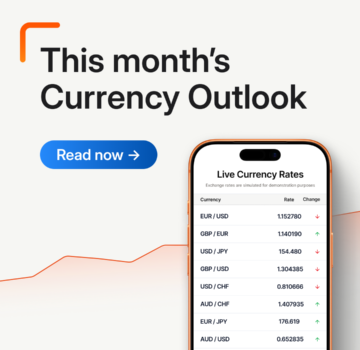Cross-border transactions: A guide to international payment systems for SMEs
Expanding internationally can be transformative for growing businesses. The ability to access new markets, acquire a diverse customer base, and increase revenue potential is undeniably appealing.
But operating in multiple countries is not without its challenges.
Often overlooked among these: the intricacies of international payments. While cross-border transactions provide opportunities for growth, they also bring a set of issues that can cause major operational disruptions.
To ensure that international transactions are as seamless and cost-effective as possible, you must understand how global payment systems work and the potential risks associated with cross-border payments.
Whether you’re sending payments across the European Union, dealing with currency conversions in Asia, or processing payments in the United States, understanding the landscape lets you avoid delays, hidden fees, and regulatory pitfalls.
This article takes you through various payment systems used in key business regions. We outline what you need to know when making international payments and how to optimise your approach to global financial transactions.
What are international payment systems?
Globalization has made the world feel smaller. Doing business internationally is simpler than ever, and global financial systems are increasingly interconnected and similar to one another.
But each country still has its own banking infrastructure, payment networks, and regulations governing how money is transferred both domestically and across borders. These payment systems are deeply embedded in the local financial ecosystem.
From the United States and Europe to Asia and Latin America, each region’s payment mechanisms vary significantly, which can have a profound effect on how you send and receive funds.
For example, some countries rely on older banking networks that may have slower processing times, while others have adopted newer real-time payment systems that allow for nearly instantaneous transfers. Each payment network comes with its own set of transaction fees, processing times, and requirements that can significantly impact your ability to manage cash flow effectively.
International payments often involve complex regulations, especially around currency exchange, tax laws, and anti-money laundering (AML) requirements. For businesses that aren’t fully aware of these regulations, non-compliance can result in hefty fines, delayed transactions, and even reputational damage.
Why the differences matter
Understanding the complexities of global payment systems is crucial to operate smoothly and avoid common pitfalls such as delays, high transaction fees, and compliance issues. Each payment network comes with its own set of benefits and limitations.
Some offer fast, low-cost transactions, while others are more suited for large or high-value payments. And all have specific rules and processes to master for smooth payments.
No matter the system, you must be aware of the various regulations, currency controls, and potential hidden fees that may arise when making cross-border transactions. These nuances can quickly add up, leading to financial inefficiencies, delays, and even compliance risks.
In short, you must get deeply familiar with the specific systems in each market you enter.
6 key international payment systems to know
Each country operates with its own domestic and international payment systems. While certain payment networks are used globally, others are regional or even country-specific.
Here’s an overview of some of the most significant payment systems across different regions and what businesses should keep in mind when sending payments internationally.
United States: ACH & Fedwire
In the United States, businesses have a few payment system options for domestic and international transactions. The most widely used for domestic payments include ACH (Automated Clearing House) and Fedwire.
- ACH (Automated Clearing House): ACH is a network that processes a high volume of low-value payments. It is most commonly used for payroll, supplier payments, and bill payments. ACH payments are cost-effective and have low fees, making them ideal for regular transactions.
But ACH payments can take 2-3 business days to clear, which may not be suitable for businesses that need to transfer funds quickly.
- Fedwire: Fedwire is a real-time gross settlement (RTGS) system, designed for high-value payments. It allows for the immediate transfer of funds and is typically used for large transactions like mergers, acquisitions, and real estate deals.
What to watch for
While ACH is inexpensive and convenient, it can be slow, which may create delays in cash flow. In response to demand for faster processing, Same Day ACH was recently introduced. This lets certain payments be processed and settled on the same day they are initiated. But it typically has slightly higher fees than standard ACH and comes with transaction amount limits (currently $1 million per payment).
Fedwire, meanwhile, allows for immediate transactions but tends to have higher transaction fees, especially for large payments.
Europe: SEPA (Single Euro Payments Area)
The European Union (EU) has standardized payment systems for transactions within the Eurozone, known as SEPA (Single Euro Payments Area). SEPA lets businesses and individuals make domestic and cross-border payments in euros, ensuring greater efficiency, lower costs, and faster transfers.
- SEPA Credit Transfers (SCT): This system standardizes cross-border payments between EU countries. Payments are typically processed within one business day, making it an efficient option for businesses operating within the EU.
- SEPA instant payments: Available in several European countries, this system allows for real-time payments between banks, 24/7, which can be a game-changer for businesses needing immediate transactions.
- SEPA Direct Debit (SDD): SDD is useful for businesses that collect regular payments from customers, such as subscriptions. Payments are pulled automatically from a customer’s bank account once authorisation is given. It’s a major tool for recurring billing models in Europe, including SaaS companies and membership organizations.
What to watch for
Not all banks across Europe support SEPA Instant payments, meaning some transfers may take longer than expected. Additionally, businesses making cross-currency payments (for example, from euros to British pounds) should note that these transfers are not covered by SEPA rules and may incur extra fees.
United Kingdom: Faster Payments, BACS & CHAPS
The U.K. has a variety of systems for domestic payments, including Faster Payments, BACS, and CHAPS, each serving a specific purpose and offering different benefits.
- Faster Payments: This is the most commonly used payment system in the UK for fast transactions. Payments can be processed in near-real time, meaning businesses can send and receive funds almost instantly.
Faster Payments typically have a limit of £1 million per transaction (as of 2024).
- BACS (Bankers’ Automated Clearing System): BACS is one of the oldest and most widely used systems in the UK, typically for bill payments and regular payments between businesses and customers. BACS payments take about 2 business days to settle, which can be slow for businesses that need quicker access to funds.
- CHAPS (Clearing House Automated Payment System): CHAPS is designed for high-value, same-day payments. It’s commonly used for large transactions, including property transactions and payments between financial institutions.
What to watch for
While Faster Payments are quick, some UK banks have transaction limits on the amount that can be transferred via this system. And individual banks may set lower limits, particularly for personal or small business accounts.
For larger transactions, businesses may need to use CHAPS, which can come with higher fees.
Additionally, payments made via BACS may take longer to settle, which can affect cash flow for businesses that need faster payments.
Canada: EFT & Interac
In Canada, businesses can use EFT (Electronic Funds Transfer) and Interac, two widely used systems for domestic and international payments.
- EFT (Electronic Funds Transfer): EFT is the standard system used for bank-to-bank transfers within Canada. It’s a secure and reliable way to transfer funds between businesses and individuals.
EFT payments can take several days to process, which can create delays in accessing funds.
- Interac: Interac is a widely used network in Canada for both personal and business payments, although it’s mainly used by individuals. It allows for quick transfers, but it’s mainly limited to domestic payments.
Interac e-Transfer for Business: This newer service is tailored for businesses that need faster payments and larger transaction limits compared to personal Interac transfers. It supports real-time settlements and richer remittance data.
What to watch for
EFT payments can take several days to process, which may not be ideal for urgent payments. Additionally, international transfers from Canadian banks often come with high foreign exchange margins, which could make cross-border payments expensive.
Australia: NPP & BPAY
In Australia, NPP (New Payments Platform) and BPAY are two key payment systems that businesses use to facilitate domestic transactions.
- NPP (New Payments Platform): The NPP allows for real-time payments, making it an excellent option for businesses that need immediate access to funds. The system operates 24/7, providing businesses with more flexibility for sending and receiving payments.
- BPAY: BPAY is a popular payment system used in Australia for bill payments and direct debits. It’s widely accepted by Australian businesses and provides a convenient method for businesses to manage regular payments.
PayID (works via NPP): Businesses can link their bank account to an easy-to-remember identifier (like a phone number or email address), simplifying the payment process and improving customer experience.
What to watch for
While NPP is quick and efficient, some Australian banks still rely on the traditional SWIFT network for international payments, which could cause delays. This is important to note for businesses that operate internationally and require fast cross-border payments.
Asia: China’s CIPS & India’s UPI
In Asia, two notable payment systems have emerged: CIPS (China International Payment System) and UPI (Unified Payments Interface).
- CIPS (China International Payment System): CIPS is China’s dedicated payment system for cross-border transactions, specifically for payments in Chinese yuan (CNY). This system is used primarily by businesses trading with Chinese companies.
- UPI (Unified Payments Interface, India): UPI is a fast-growing real-time payments network in India, facilitating seamless transactions between banks. UPI has gained rapid adoption due to its ease of use and availability across various financial institutions.
What to watch for
Businesses engaging in trade with China or India should be aware of the local regulatory environments. In China, currency controls can affect cross-border payments, while businesses operating in India should understand the UPI system’s limits and interoperability with international payment systems.
Both systems are progressing quickly. CIPS is increasingly integrated with SWIFT standards, making it easier for businesses outside China to connect without needing direct renminbi (RMB) clearing bank relationships. And some Indian banks are exploring ways to link UPI with foreign payment systems (e.g., UPI-SWIFT tie-ups), which could broaden UPI’s usefulness for international business over time.
Get smart about cross-border transactions
International payments are getting easier and faster as time goes by. But paying global suppliers and staff, or accepting customer transactions from overseas, will probably never be as simple as moving cash domestically.
Each country has its own unique payment infrastructure, regulatory requirements, and banking systems, which can significantly impact how international payments are processed. This is why staying informed about the payment systems in the regions you operate is key to minimising disruptions and ensuring a seamless flow of money.
Whether you’re using ACH and Fedwire in the U.S., SEPA in the E.U., CIPS in China, or SWIFT just about everywhere, there will always be costs and operational hurdles to consider.
To work efficiently and save real money, you need the right tools.
How OFX can help
OFX is a global payment platform that simplifies the process of sending and receiving international payments. You get a fast, secure, and cost-effective way for businesses to transfer funds across borders, without the typical complexity and risk associated with global payments.
Here’s how OFX can help:
- Competitive exchange rates: OFX offers access to competitive exchange rates, ensuring you get the best deal on every currency conversion.
- Low fees: Unlike traditional banks, OFX charges lower fees for international transfers, helping you save money on cross-border payments.
- Global reach: OFX operates in over 190 countries, providing businesses with the flexibility to send payments to a wide range of destinations. Whether you’re sending money to Europe, Asia, or North America, payments are delivered efficiently.
- 24/7 access: Get round-the-clock access to your payment platform to send payments at any time of the day or night.
- Enhanced security: The platform uses advanced encryption to protect sensitive information and ensure secure transactions.
- Expert support: Your support team is available to assist with any questions or concerns related to international payments. This guidance ensures you make informed decisions about cross-border transactions.
Working with a reputable payment partner like OFX is vital to successfully navigate the complexities of international transactions. With the right tools and knowledge, you can save time and money, improve cash flow, and ensure you’re always one step ahead in the ever-evolving global marketplace.
Ready to streamline your international payments? Get started with OFX today, visit ofx.com/business
This article is purely for informational purposes only and should not be treated as advice. OFX will not be held liable for any losses incurred as a result of individuals or businesses relying on the information contained in this article



